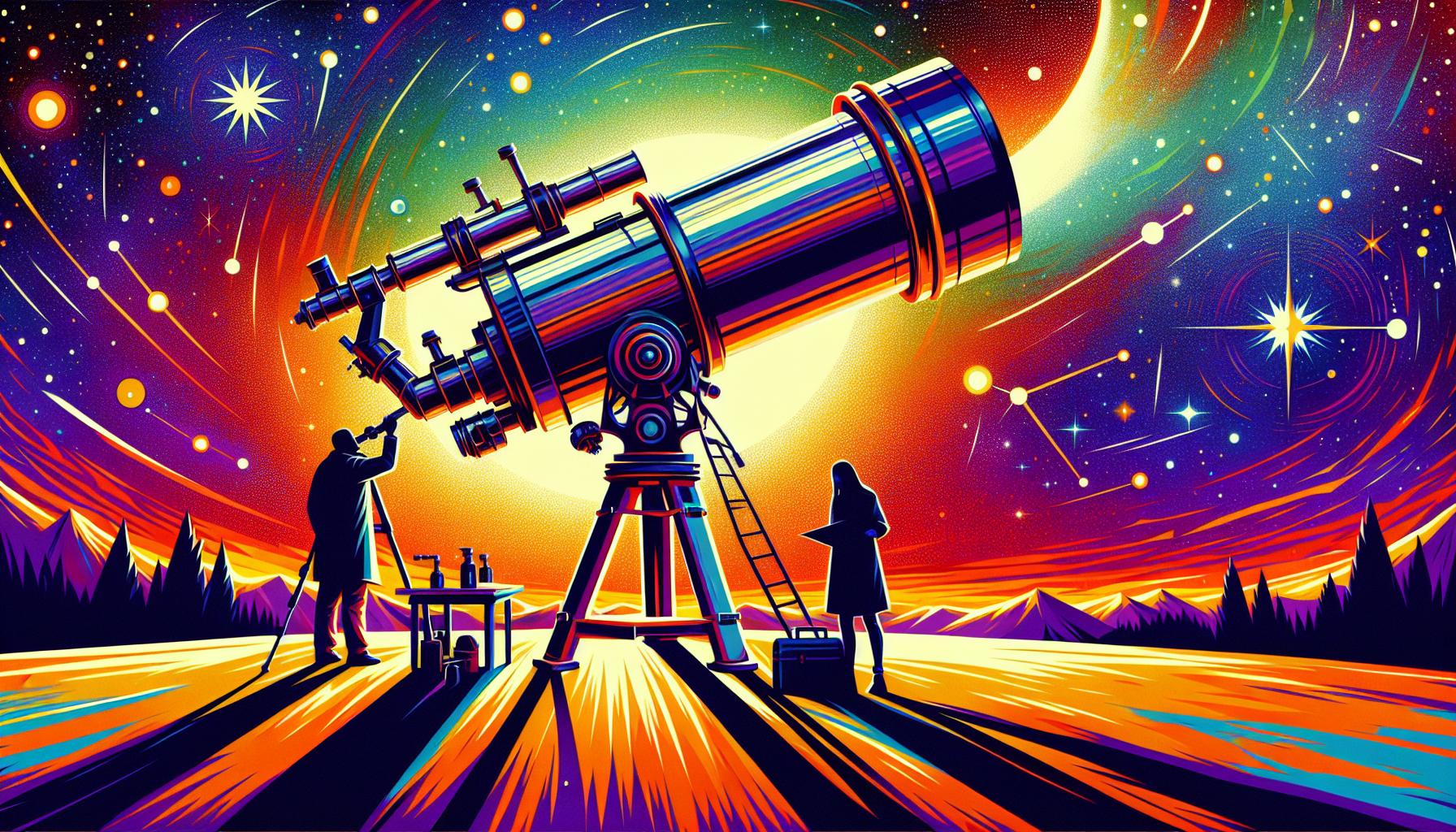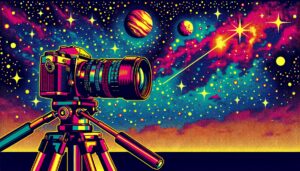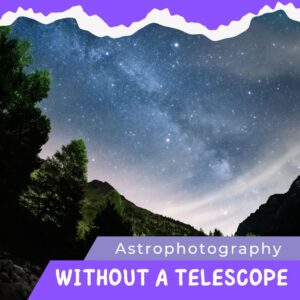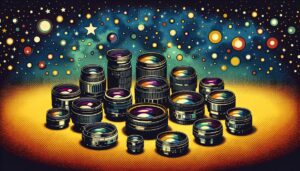This site contains affiliate links to products. I may receive a commission for purchases made through these links.
Astrophotography’s a captivating hobby that’s been gaining traction in recent years. It’s the art of capturing the beauty of the cosmos, and the right telescope can make all the difference. But with so many options out there, it’s hard to know which one’s best for astrophotography.
I’ve been gazing at the stars for years, and I’ve tried and tested numerous telescopes. I’ll be sharing my insights on the best telescopes for astrophotography, helping you make an informed decision. Whether you’re a newbie or a seasoned stargazer, there’s a perfect telescope out there just for you.
Remember, astrophotography’s not just about the gear, but also about patience and passion. So, let’s embark on this stellar journey together and unravel the mysteries of the universe one snapshot at a time.
Factors to consider when choosing a telescope for astrophotography
When diving into the world of astrophotography, having a quality telescope can be a game-changer. Your choice of telescope can dramatically affect your final images of the cosmos. Here are the factors to consider when choosing a telescope for that starry shot.
One of the most critical factors to consider is the aperture of a telescope. It’s essentially the diameter of the telescope’s lens or mirror. A larger aperture collects more light, enabling us to view faint objects in deep space. When selecting your first telescope, it’s highly recommended to go for the one with the largest aperture you can afford.
Next up, we have the focal length. It is the distance between the telescope’s primary lens or mirror and the point where the light comes into focus. A longer focal length means a larger image scale and better ability to see far-off objects. It’s a significant factor when trying to capture celestial bodies, so bear this in mind when choosing your telescope.
Another factor to note is the mount type. You may not think it’s essential, but trust me – it is! A reliable and sturdy mount is vital when delving into astrophotography, especially long-exposure shots where even the slightest vibration can blur your images.
Lastly, consider the camera compatibility. Ensure your chosen telescope can be connected to a DSLR or other suitable camera for astrophotography. Without this compatibility, it’ll be hard to get into astrophotography at all!
To make these considerations more digestible, here’s a brief table summary:
| Factor | Why it’s Important |
|---|---|
| Aperture | Determines sensitivity to light, impacting ability to view faint objects |
| Focal Length | Affects scale of images and ability to view far-off celestial bodies |
| Mount Type | Ensures stability, crucial for long-exposure shots |
| Camera Compatibility | Allows connection to cameras, enabling astrophotography |
These factors are crucial in grasping the perfect image of our night sky. Remember – patience and passion are key in this field. With these, even the darkest corners of the universe can’t hide from your telescope.
Telescope type: Refractor vs. Reflector vs. Compound
Coming up next in our discussion on the best telescopes for astrophotography is the type of telescope. You’ve got three main options: refractor, reflector, and compound telescopes. Each offers unique benefits and downsides to consider.
Refractor Telescopes:
Refractor telescopes use lenses to gather and focus light. They’re great for viewing bright objects like the moon, planets, and stars. You’ll notice that refractor scopes usually have high optical quality, providing sharp and contrasting images.
Yet, there’s a downfall. Larger refractor telescopes can get quite expensive. They tend to be bigger too, hence not as portable. But for those ready to invest both money and space for enriching the astrophotography experience, these can be great fits.
Reflector Telescopes:
On the flip side, reflector telescopes use mirrors instead of lenses. Their design reduces chromatic aberration, a type of distortion found in refractor telescopes. They can also provide clear, detailed views of faint deep-space objects like galaxies or nebulae.
However, reflector telescopes may require more maintenance than others. The mirrors have to be cleaned and realigned regularly, which could be a bit off-putting for some.
Compound (or Catadioptric) Telescopes:
Lastly, we have compound telescopes. They combine the best features of refractors and reflectors. Thanks to their special lens-and-mirror design, they’re compact and versatile. Ideal for viewing both terrestrial and celestial objects.
Here too, there are trade-offs. Compound telescopes can be relatively expensive and their complex optical design may introduce some image distortion, especially around the edges.
Can we clearly say one is better than others? No, because it’s primarily about the photographer’s individual needs. It’s about what you plan to capture, your budget, and your comfort with the maintenance involved.
Aperture size and its impact on astrophotography
Moving forward, another critical factor I want to discuss is aperture size and how it impacts the quality of the astrophotography.
The aperture of a telescope refers to the diameter of the lens or mirror that gathers light. In simple terms, it’s the ‘eye’ of the telescope. Bigger eyes see better and the same principle applies to telescopes. A larger aperture provides a brighter and more detailed view, which is key in astrophotography.
One pertinent fact to keep in mind is that when it comes to aperture, bigger is always better. It’s because larger apertures gather more light, rendering better resolution and clearer images of deep-space objects.
| Telescope Type | Aperture Consideration |
|---|---|
| Refractor | Limited Aperture Size |
| Reflector | Larger Apertures Available |
| Compound | Versatile Aperture Size |
Refractors usually have a limited aperture size due to glass quality requirements and potential weight issues that impact portability. Reflectors, by nature of their design, allow for larger apertures. Compound telescopes, being a hybrid of the two, offer a balance.
However, a larger aperture can be cost-prohibitive and less portable. It’s not just about getting the biggest aperture you can. Other factors such as your budget, portability requirements, and what you plan to image should be taken into account.
Light pollution can also affect the performance of larger apertures. If you’re in a highly illuminated area, a bigger aperture might not perform any better than a smaller one. In these situations, investing in good filters can make a significant difference.
Considering all these factors, it becomes clear that understanding aperture size is a vital aspect any budding astronomer or astrophotographer must grasp to make an informed telescope purchase. Remember, it’s not just about the type of telescope; the aperture size has a direct influence on the quality of the images you’ll capture. As we continue our discussion, we’ll dive into more complex topics, ensuring you’re well-equipped to navigate the skies.
Mount and tracking capabilities for accurate imaging
Pivoting over to the discussion of mounts and tracking capabilities, it’s important to understand that the earth’s rotation can have a significant effect on your astrophotography shots. No matter the telescope’s aperture size, without the right mount, your deep-space images will appear blurry or streaky.
The two most popular types of mounts for astrophotography are Altitude-Azimuth (Alt-Az) and Equatorial mounts.
The simpler one, the Alt-Az mount, operates on a basic up-down, left-right mechanism. This type of mount is intuitive and easy to use. However, it’s not best suited for long-exposure astrophotography, as it cannot simultaneously adjust for the Earth’s rotation on both axes.
Contrarily, an Equatorial mount is better equipped for astrophotography. It aligns with the Earth’s rotation. This feature is essential in tracking stars, planets, and other deep-space objects accurately throughout the night. Although they may require a bit of a learning curve, equatorial mounts can immensely improve the quality of your astrophotos and are worth the investment for serious amateurs who want crisp, clear images.
Let’s produce those numbers for clarity:
| Type of Mount | Ease of Use | Suitable for Long-Exposure Astrophotography |
|---|---|---|
| Altitude-Azimuth (Alt-Az) | Easy | No |
| Equatorial | Requires Learning | Yes |
In addition to a good mount, a motor drive or computerized tracking system can free you from manual tracking. It’s an invaluable tool that compensates for Earth’s rotation by moving the telescope at the same speed but in the opposite direction. If your hobby is headed towards deep-space astrophotography, this feature could be a game-changer. But remember, quality tracking systems can be pricey.
When scouting for the best telescope for astrophotography, my advice is to not overlook the value of strong mount and tracking capabilities. This might just be your secret to capturing those breathtaking celestial shots you’re aiming for.
Best telescopes for beginners in astrophotography
Moving from the importance of mounts and tracking capabilities, let’s delve into the best telescopes for beginners in astrophotography. With the right telescope, capturing breathtaking images of celestial objects becomes easier. However, the myriad options available can be overwhelming for newcomers. Fear not; I’m here to help!
(Orion 10034 GoScope II) and (Celestron NexStar 130 SLT) are two models that have proven exceptionally beginner-friendly.
Orion 10034 GoScope II is a compact, easy-to-use refractor telescope and is an excellent option for beginners. It’s got an 80mm objective lens that provides bright, sharp images, ideal for realizing those first ventures into astrophotography.
On the other hand, the Celestron NexStar 130 SLT is a reliable computerized telescope that aligns itself with celestial objects. This one’s a Newtonian Reflector, and it offers sky alignment technologies, making it easier to locate celestial bodies and track them precisely. Its ability to quickly find and track celestial objects makes the learning curve easier for those new to the field. It’s got an aperture of 130mm, offering clarity and great detail to both novice astronomers and photographers.
Here are the specifications of each telescope:
| Telescope Model | Type | Aperture | Mount Type |
|---|---|---|---|
| Orion 10034 GoScope II | Reflector | 80mm | Alt-Azimuth |
| Celestron NexStar 130 SLT | Newtonian Reflector | 130mm | Computerized Altitude-Azimuth |
Ease of use, versatility, and affordability make these two scopes stand out choices for newcomers to astrophotography. Keep in mind, choosing your first telescope is about what’s best for you—your interests, the level of complexity you’re comfortable with, and your budget. Before making a decision, weigh these factors against the telescope’s specifications and capabilities.
After identifying the perfect telescope for your needs, gradually start experimenting with your technique, remember that great practice comes with exploring different camera settings, angles, and timings.
Best telescopes for intermediate astrophotographers
Stepping up from the beginner’s level, intermediate astro-imagers often seek performance and additional features in their telescopes. Two perfect picks for these mid-level enthusiasts are the Sky-Watcher ProED 120mm Doublet APO Refractor and the Orion Atlas 8 EQ-G GoTo Reflector Telescope.
Let’s delve into the characteristics that make them the right choices for intermediate astrophotographers.
Sky-Watcher ProED 120mm Doublet APO Refractor
The Sky-Watcher ProED stands out due to its well-regarded doublet apochromat optics. With its large 120mm objective lens, it’s capable of capturing detailed and high-resolution images of deep-sky objects. This telescope minimizes chromatic aberration to a commendable level. It’s a tad pricier than beginner telescopes, yet brings in a significant return in terms of image quality.
Orion Atlas 8 EQ-G GoTo Reflector Telescope
On the flip side, there’s the Orion Atlas 8 EQ-G. This model is a computerized reflector telescope featuring an 8-inch aperture. It also comes with a substantial database of celestial objects, making it easier for you to track and photograph desired targets. The added feature of automated GoTo tracking sets it apart. It’s an excellent investment for those who prioritize efficiency and precision in their cosmic exploration.
As an intermediate astrophotographer, you’re ready to plunge deeper into the universe. The choice between a refractor and a reflector type thus becomes more crucial. You have to strike a balance between budget, performance, and features to fullfill that stargazing zeal.
As you’ve likely gathered from your beginner’s experience, astrophotography requires trial and error, patience, and constant learning. Whichever telescope you choose, remember to stretch its limits, to test various camera settings, angles, and timings to continually refine your technique. Every new image you capture brings a better understanding of your equipment, and helps you to grow as an astro-imager. You’re on an exciting journey that doesn’t merely stop at owning a telescope, but rather lives on in each thrilling discovery you make.
Best telescopes for advanced astrophotographers
It’s now time to delve into the next level – the best telescopes for advanced astrophotographers. As an experienced astrophotographer, you’ll want to invest in a telescope that’s capable of capturing high-resolution, detailed images of those distant galaxies, nebulae, and other celestial wonders. You’ll also need a telescope with more professional-level features like advanced tracking systems, larger aperture, and superior optics.
Two stellar models that I’d highly recommend to any advanced astrophotographer are the Celestron’s Advanced VX 8″ Schmidt-Cassegrain Telescope (SCT) and the Explore Scientific ED152 Air-Spaced Triplet Apochromatic Refractor.
The Celestron’s Advanced VX 8″ SCT prides itself on offering great features like a GoTo mount with a database of over 40,000 celestial objects and Periodic Error Correction (PEC). This feature-rich SCT is designed for mobility. It’s perfect for astrophotographers who enjoy travelling to dark-sky locations.
On the other hand, the Explore Scientific ED152 offers professional-level quality with its three-lens apochromatic design. This refractor telescope produces images free of chromatic aberration across the entire field of view. Its large 152mm aperture allows for greater light gathering and resolution.
Here is a quick comparison:
| Telescope Model | Aperture | Special Features |
|---|---|---|
| Celestron’s Advanced VX 8″ SCT | 8″ (200mm) | GoTo Mount, PEC, High Mobility |
| Explore Scientific ED152 | 6″ (152mm) | APO design, Large Aperture |
Financial investment for these advanced telescopes can be steep. But with the quality of images they can help you capture, surely they’re worth every cent. After all, the beauty of the heavens isn’t meant to be viewed through subpar equipment.
Conclusion: Finding the perfect telescope for your astrophotography journey
Choosing the right telescope for astrophotography isn’t a decision to take lightly. The Celestron’s Advanced VX 8″ SCT and the Explore Scientific ED152 stand out as top choices for advanced astrophotographers. They offer exceptional features and professional-grade image quality.
Yes, they’re quite an investment. But for the quality of images you’ll get, they’re worth every penny. Remember, astrophotography is a journey, not a destination. It’s about exploring the universe, capturing its beauty, and continuously learning. So, choose a telescope that’ll support your journey and help you reach new heights in your astrophotography endeavors.
FAQ
What telescopes are recommended for advanced astrophotographers?
The Celestron’s Advanced VX 8″ Schmidt-Cassegrain Telescope and the Explore Scientific ED152 Air-Spaced Triplet Apochromatic Refractor are two highly recommended telescopes for advanced astrophotographers.
What makes Celestron’s Advanced VX 8″ SCT suitable for astrophotographers?
The Advanced VX 8″ SCT features a GoTo mount with a database of over 40,000 celestial objects, and it offers Periodic Error Correction (PEC). It’s particularly useful for astrophotographers who like taking their gear to dark-sky locations.
What are the special features of the Explore Scientific ED152 Air-Spaced Triplet Apochromatic Refractor?
The Explore Scientific ED152 features a three-lens apochromatic design. This leads to images that are free of chromatic aberration across the entire field of view, offering professional-level image quality.
Are advanced telescopes for astrophotography worth the investment?
Yes. While the upfront cost for these advanced telescopes can be high, the extraordinary quality of images they can produce makes them a worthy investment for serious astrophotographers.




